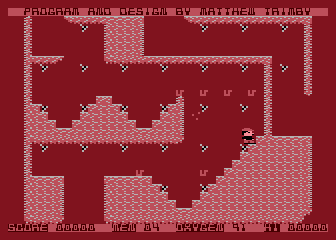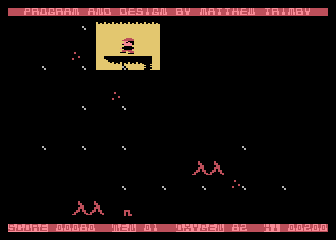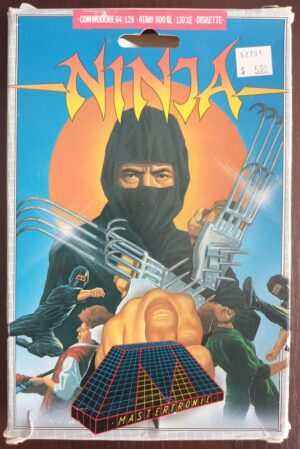Retro Replay Review
Gameplay
Crystal Raider offers a tight, exploration-driven platforming experience that challenges players to balance precision movement with strategic planning. Each of the 50 intricately designed rooms is packed with crystals to collect, hidden passages, and multiple exits that branch into new segments of the level. You’ll need to master a limited thrusting ability—think of it as a short, controlled burst of upward movement—to navigate tricky jumps and avoid falling into deadly pits.
(HEY YOU!! We hope you enjoy! We try not to run ads. So basically, this is a very expensive hobby running this site. Please consider joining us for updates, forums, and more. Network w/ us to make some cash or friends while retro gaming, and you can win some free retro games for posting. Okay, carry on 👍)
The game’s life and oxygen systems introduce a satisfying layer of tension. You begin with five lives and an oxygen meter that constantly ticks down, so every second counts. Touching a moving “nasty” or letting your oxygen deplete sends you back to the start of the current screen, but keeps any crystals you’ve already gathered. This design choice softens the blow of failure and encourages you to replay rooms, learning from your mistakes without losing all your progress.
For players seeking an added layer of difficulty, Night mode restricts your visibility to a small radius around the character. This creates a truly atmospheric challenge, forcing you to memorize level layouts and anticipate threats lurking just beyond your light. Night mode transforms the game into a tense, almost stealth-like puzzle, making successful runs feel all the more rewarding.
Graphics
Visually, Crystal Raider embraces a retro aesthetic that pays homage to classic 8-bit and 16-bit platformers. The sprites are crisp and well-animated, with each crystal shimmering delightfully against the darker hues of cavern walls. Though simplistic by modern AAA standards, the charm lies in the clarity of design: you can instantly distinguish between safe platforms, breakable floors, and menacing enemies.
The color palette shifts to suit each region of the underground complex, offering a sense of progression as you delve deeper into the game’s subterranean world. Bright jewel tones highlight collectible items, while muted earth tones and subtle gradients convey the oppressive atmosphere of forgotten ruins. Combined with minimal but effective background details—stalactites, ancient carvings, and glowing fungi—this visual approach balances nostalgia with readable, purposeful design.
Night mode also introduces dynamic lighting effects that, though simple, significantly boost immersion. A soft halo of light surrounds your character, casting faint shadows on nearby walls. This not only heightens the sense of danger but also showcases how thoughtful graphical tweaks can deepen the overall gaming experience without demanding high-end hardware.
Story
While Crystal Raider doesn’t rely on cutscenes or extensive dialogue, it delivers its narrative through environmental storytelling and gameplay stakes. You assume the role of an intrepid explorer on a quest for otherworldly crystals rumored to grant untold powers. The silent protagonist approach keeps the focus squarely on gameplay, allowing the twisting corridors and hidden vaults to speak for themselves.
As you advance through multiple zones—ancient temples, crystalline caverns, and mechanical vaults—you pick up subtle lore clues etched into walls or implied by the design of each room. Every new area feels like a piece of a larger puzzle, gradually revealing a forgotten civilization’s obsession with harnessing crystalline energy. This minimalist storytelling draws you in, encouraging you to imagine the world beyond what’s shown on screen.
The scarcity of explicit narrative elements also serves a practical purpose: it keeps the pacing brisk. You’re never pulled away from the core platforming loops, and each new room becomes a fresh chapter in your personal adventure. For players who appreciate games that tell stories through level design rather than long expositions, Crystal Raider strikes a pleasing balance.
Overall Experience
Crystal Raider delivers a compelling mix of exploration, challenge, and retro charm, making it a standout title for fans of classic platformers. The interplay between limited thrust mechanics, oxygen-based time pressure, and the risk-reward cycle of collecting every crystal keeps the gameplay loop engaging from start to finish. The inclusion of Night mode further extends replayability, offering veterans a true test of memory and skill.
Newcomers to the genre will find the learning curve fair but firm: early rooms ease you in, teaching you to manage thrust and timing, while later stages demand precision and strategic planning. The decision to recycle collected crystals after a death softens frustration and makes continued progress feel attainable, even on more difficult screens.
Ultimately, Crystal Raider’s strengths lie in its focused design and nostalgic presentation. It doesn’t overpromise with sprawling narratives or flashy graphics, but it does deliver a polished, thoughtfully crafted platforming adventure. If you’re seeking a game that rewards exploration, adaptability, and perseverance, you’ll find Crystal Raider to be an immensely satisfying journey.
 Retro Replay Retro Replay gaming reviews, news, emulation, geek stuff and more!
Retro Replay Retro Replay gaming reviews, news, emulation, geek stuff and more!









Reviews
There are no reviews yet.